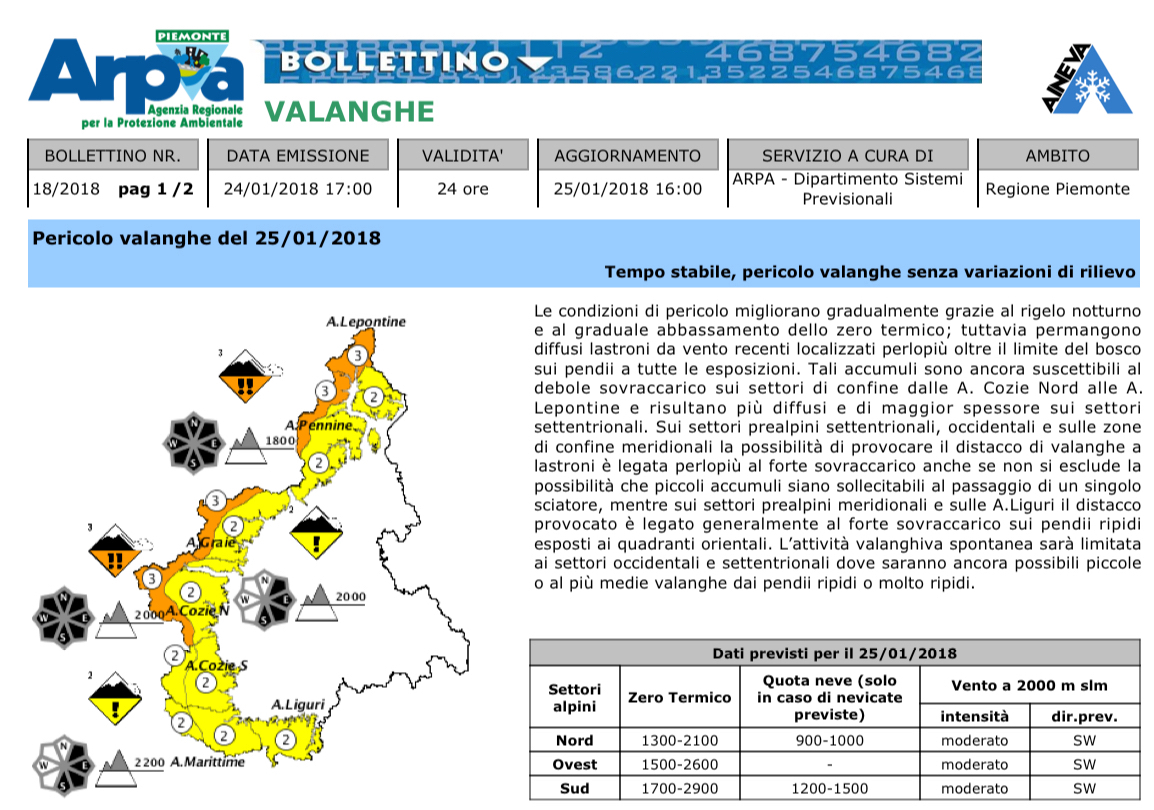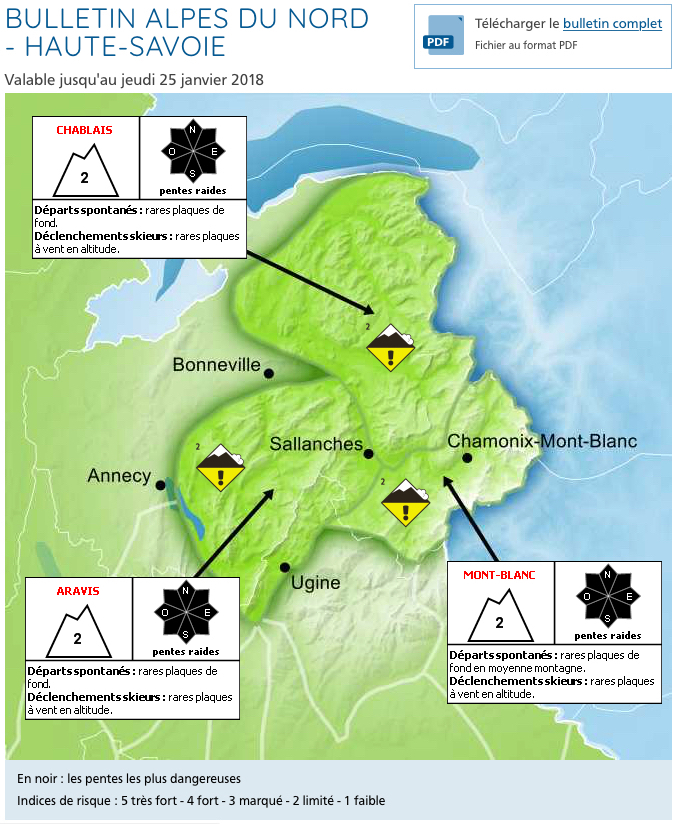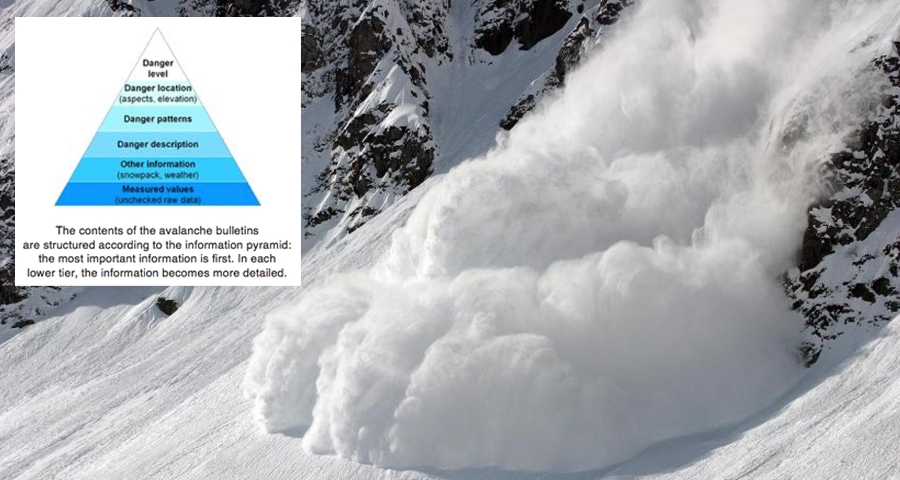Written by Jonathan
29th January 2018
avalanche, training, mountain, safety, Transciever
Avalanche Forecasting - Introduction:
Avalanche forecasts and information bulletins provide useful information that can help inform decision making and risk assessments in relation to planning activities in the mountains. Detailed, localised information will assist in the process of conducting a methodical review of both the overall level of danger presented by avalanches, and a refined assessment as to the risks presented by specific conditions of instability in the snowpack in relation to the slope aspect (the direction in which the slope faces), its profile, topography and gradient, and with respect to the role played by altitude (influencing, inter alia, factors such as temperature, precipitation and wind velocity).
Familiarise yourself with the avalanche bulletin services specific to the area you plan to visit: it’s important to be aware of the frequency of the bulletins provided, and to know how the service is updated. For example, better resourced services may have more regular updates, and may also prepare additional information during exceptional events (for instance, in the event of especially heavy snowfall). A familiarity with the service, and a good comprehension of how it is run, will best help you assess and determine the value of the information you use to make your decisions. Realistically, every service is to an extent restricted in terms of the resources at its disposal — knowing these limitations will help you gauge where gaps might appear in your ability to reach an informed basis for calculating the safety level of your planned activity.
Keep an eye on the frequency of bulletins, and ensure you’ve the most up to date information when making decisions. Technologies are not infallible. Web-based services are not immune to the same technical glitches you’d experience with any other online service… so do double-check the date and timing of announcements (it’s amazing how a simple oversight such as a cached page can be overlooked, presenting you with report that’s potentially already out of date!). Check too whether there’s a phone-based recorded information service for your area: this can be especially helpful when you’ve poor cellular service and limited bandwidth to check a website.

European Avalanche Warning Services:
The European Avalanche Warning Services (EAWS) website is a very useful online tool for those heading into the mountains. The homepage of the service provides a map of Europe with the EAWS countries that provide avalanche warning services shaded in blue. By zooming into these areas and clicking you can access the local bulletins. As detailed above, the frequency of the updates and the functionality relating to the avalanche information service is very much dependent upon the country in question (and, with respect to Italy, for example, even the region). In particular, it’s noticeable that, frankly, politics come into play when the region’s looking to assert its autonomy… so, for Catalunya/Catalonia and Piemont/Piedmont you can expect several different bulletins covering the same geographic area provided by the national and regional authorities. One hopes there’s some coordination taking place with their respective prognoses!
A principal achievement of the EAWS is the 5-point European Avalanche Danger Scale, which has been in use throughout Europe since 1994. The uniform scale is especially useful in regions close to national borders and for people who visit different countries. Ensuring its consistent application remains a constant task of the warning services.
The content of the avalanche bulletins across Europe is now in a more standard format across the countries. In principle, the forecasts provide informational detail that builds up on levels like a pyramid, from simple to complex (danger level – avalanche prone locations – avalanche problem – danger description – snowpack and weather – raw data). With the increasing depth of information the requirements for the individual to have more refined technical avalanche assessment skills increases.
Whilst the EAWS’s Working Group has done much to develop the standards for the foundational danger scale the avalanche risk presents, and also with regard to creating the ‘information pyramid’ for ensuring basic comprehension is facilitated, there’s clearly not a norm for presenting notices and data more generally — yet! Across the various bulletins you’ll see the countries presenting information quite differently; so it’s worth familiarising yourself with the nuances before you visit a new region. When perusing the websites you’ll quickly discern how different are the ideas as to what works in communication!
It’s also important to consider that services such as EAWS are only as reliable as the sources of the data they receive: incidents aren’t always reported, so they may not appear on maps plotting where avalanches have been recorded as taking place. It’s necessary too to bare in mind that you’ll need to grapple with the local language requirements of the different local sites’ resources… don’t assume that everything’s in English (this is a noticeable contrast with most standard snow/ski resort reports and forecasts). If your German/French/Italian/Slovenian is limited, you may want to do a little homework and familiarise yourself with navigation of the reports (and with how best to use Google Translate to boot!).

To save a little time on navigation you’ll find the most commonly accessed avalanche bulletins in Europe below:
Austria – Tyrol
Austria – Voralberg
France
French Northern Alps
French Southern Alps
French Pyrenees
Germany — Bavaria
Norway
Scotland
Slovenia
Spain — Aragón-Navarra
Spain — Catalunya/Catalonia
Switzerland
 Off-Piste
Off-Piste Ski Touring
Ski Touring Via Ferrata
Via Ferrata Ice Climbing
Ice Climbing Alpine Glacier Trekking
Alpine Glacier Trekking Worldwide Trekking
Worldwide Trekking






 Travel Website Development
Travel Website Development